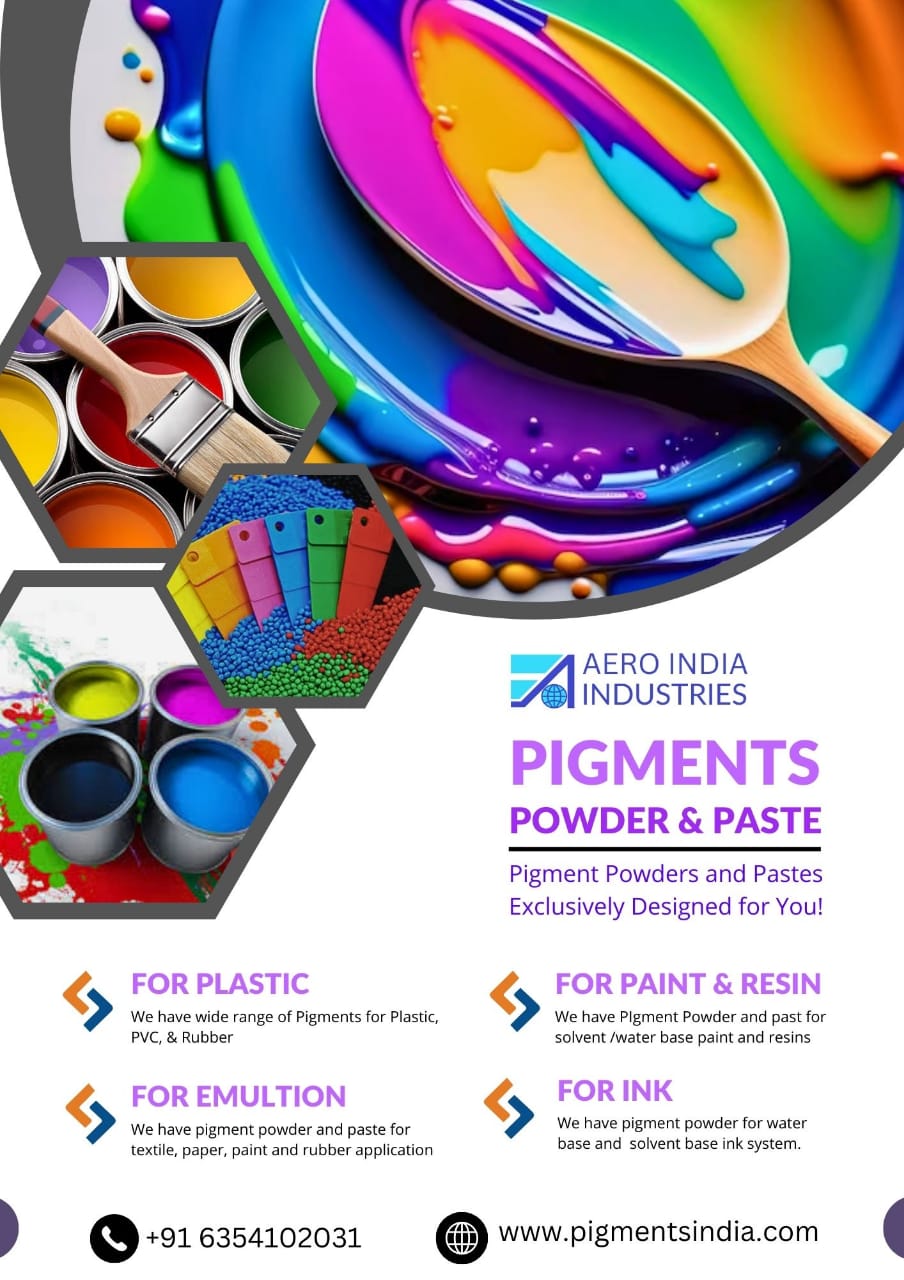How to Select the Right Pigment for Your Need When it comes to the manufacturing and production of pigments, selecting the right one can significantly impact the quality, durability, and appearance of the final product. Whether you are working with coatings, plastics, textiles, or any other material, choosing the ideal pigment requires careful consideration. AERO India, a leading name in pigment manufacturing, understands the complexities involved. In this blog, we will guide you through the process of selecting the right pigment for your needs. 1. Understand Your Application Requirements Different industries and applications have specific requirements when it comes to color, performance, and durability. Whether you're formulating paints, plastics, inks, or coatings, the first step is to assess the intended use of the pigment. Some key factors to consider include: - Color Strength & Shade: The pigment should match the desired color intensity and tone. It’s essential to know the exact shade you need, whether it's vibrant, pastel, or deep tones. - Durability: Some applications demand high resistance to wear and tear. If your product will be exposed to outdoor elements, you’ll need pigments with high UV stability, fade resistance, and heat resistance. - Opacity/Transparency: The level of opacity or transparency affects the appearance of the product. Pigments vary in transparency; for example, titanium dioxide is highly opaque, while phthalocyanine blue is more transparent. 2. Consider the Chemical and Physical Properties Pigments come in various chemical formulations and physical properties, which can significantly influence their suitability for a particular application. Some critical factors include: - Chemical Resistance: In industries like automotive coatings, where exposure to chemicals is high, selecting pigments that resist solvents, oils, and acids is crucial. - Particle Size: The size of the pigment particles determines the final finish. Fine pigments tend to provide smoother, more uniform coverage, while larger particles can offer more textured finishes. - Heat Stability: Different pigments have varying thermal resistance, and this should be considered if the end product will be exposed to high temperatures during processing or in its use. 3. Compatibility with Other Components The pigment must be compatible with other components in the formulation, including binders, solvents, and additives. Incompatible pigments can cause issues such as poor dispersion, chemical reactions, or undesirable changes in color over time. Always ensure that the pigment is tested for compatibility with your base materials. 4. Environmental Considerations In today’s world, sustainability and environmental impact are at the forefront of industrial decisions. Eco-friendly, non-toxic pigments are in high demand, especially in consumer-facing products. When selecting a pigment, consider: - Non-toxicity: Ensure that the pigment complies with regulatory standards for non-toxicity, especially in food packaging, cosmetics, or children's toys. - Environmental Impact: Opt for pigments that are low in heavy metals or hazardous substances. Many manufacturers now produce pigments that are more sustainable and safer for both the environment and human health. 5. Cost and Availability Price is always an important factor, but it's essential to balance cost with performance. Some specialty pigments may be more expensive but offer superior performance or longer-lasting color. Consider your budget and how it aligns with the long-term benefits of the pigment. - Supply Chain: Evaluate the availability of pigments. Some pigments may be scarce, which could lead to supply chain disruptions. Working with trusted suppliers like AERO India can ensure a consistent supply of high-quality pigments. 6. Test and Evaluate the Pigment Before finalizing your pigment selection, always test the pigment in your application. Conduct lab trials and evaluate the performance based on criteria such as color, texture, durability, and resistance. This allows you to identify any potential issues early on and make adjustments if needed. Conclusion Choosing the right pigment for your needs can be complex, but by carefully considering the application, physical properties, compatibility, environmental impact, and cost, you can make a well-informed decision. Companies like AERO India provide a wide range of high-quality pigments that meet these criteria and help ensure the success of your products. Remember, the right pigment can make all the difference, transforming your product from ordinary to exceptional. Take the time to evaluate your options and select the pigment that best aligns with your needs Aero Indian Industries. Odhav Ahmedabad. Manufacturer of pigment Pate and pigment Powder.
Chat with us on WhatsApp
×
This is your website preview.
Currently it only shows your basic business info. Start adding relevant business details such as description, images and products or services to gain your customers attention by using Boost 360 android app / iOS App / web portal.
https://www.aeroindiaindustries.com/latest-update/how-to-select-the-right-pigment-for-your-need-when/155
How to Select the Right Pigment for Your Need When...

2025-01-31T12:28:02
How to Select the Right Pigment for Your Need When it comes to the manufacturing and production of pigments, selecting the right one can significantly impact the quality, durability, and appearance of the final product. Whether you are working with coatings, plastics, textiles, or any other material, choosing the ideal pigment requires careful consideration. AERO India, a leading name in pigment manufacturing, understands the complexities involved. In this blog, we will guide you through the process of selecting the right pigment for your needs. 1. Understand Your Application Requirements Different industries and applications have specific requirements when it comes to color, performance, and durability. Whether you're formulating paints, plastics, inks, or coatings, the first step is to assess the intended use of the pigment. Some key factors to consider include: - Color Strength & Shade: The pigment should match the desired color intensity and tone. It’s essential to know the exact shade you need, whether it's vibrant, pastel, or deep tones. - Durability: Some applications demand high resistance to wear and tear. If your product will be exposed to outdoor elements, you’ll need pigments with high UV stability, fade resistance, and heat resistance. - Opacity/Transparency: The level of opacity or transparency affects the appearance of the product. Pigments vary in transparency; for example, titanium dioxide is highly opaque, while phthalocyanine blue is more transparent. 2. Consider the Chemical and Physical Properties Pigments come in various chemical formulations and physical properties, which can significantly influence their suitability for a particular application. Some critical factors include: - Chemical Resistance: In industries like automotive coatings, where exposure to chemicals is high, selecting pigments that resist solvents, oils, and acids is crucial. - Particle Size: The size of the pigment particles determines the final finish. Fine pigments tend to provide smoother, more uniform coverage, while larger particles can offer more textured finishes. - Heat Stability: Different pigments have varying thermal resistance, and this should be considered if the end product will be exposed to high temperatures during processing or in its use. 3. Compatibility with Other Components The pigment must be compatible with other components in the formulation, including binders, solvents, and additives. Incompatible pigments can cause issues such as poor dispersion, chemical reactions, or undesirable changes in color over time. Always ensure that the pigment is tested for compatibility with your base materials. 4. Environmental Considerations In today’s world, sustainability and environmental impact are at the forefront of industrial decisions. Eco-friendly, non-toxic pigments are in high demand, especially in consumer-facing products. When selecting a pigment, consider: - Non-toxicity: Ensure that the pigment complies with regulatory standards for non-toxicity, especially in food packaging, cosmetics, or children's toys. - Environmental Impact: Opt for pigments that are low in heavy metals or hazardous substances. Many manufacturers now produce pigments that are more sustainable and safer for both the environment and human health. 5. Cost and Availability Price is always an important factor, but it's essential to balance cost with performance. Some specialty pigments may be more expensive but offer superior performance or longer-lasting color. Consider your budget and how it aligns with the long-term benefits of the pigment. - Supply Chain: Evaluate the availability of pigments. Some pigments may be scarce, which could lead to supply chain disruptions. Working with trusted suppliers like AERO India can ensure a consistent supply of high-quality pigments. 6. Test and Evaluate the Pigment Before finalizing your pigment selection, always test the pigment in your application. Conduct lab trials and evaluate the performance based on criteria such as color, texture, durability, and resistance. This allows you to identify any potential issues early on and make adjustments if needed. Conclusion Choosing the right pigment for your needs can be complex, but by carefully considering the application, physical properties, compatibility, environmental impact, and cost, you can make a well-informed decision. Companies like AERO India provide a wide range of high-quality pigments that meet these criteria and help ensure the success of your products. Remember, the right pigment can make all the difference, transforming your product from ordinary to exceptional. Take the time to evaluate your options and select the pigment that best aligns with your needs Aero Indian Industries. Odhav Ahmedabad. Manufacturer of pigment Pate and pigment Powder.
2025-01-31T12:28:02
Keywords
- 3 compatibility
- transparent 2
- 1 understand
- nontoxicity ensure
- make adjustments
- pigment powder
- pigment pate
- pigment selection
- pigment complies
- balance cost
- availability price
- transparency affects
- application requirements
- chemical formulations
- pigments selecting
- end product
- final product
- chemical resistance
- highquality pigments
- specialty pigments
- produce pigments
- difference transforming
- products remember
- wide range
- performance based
- consistent supply
- trusted suppliers
- longterm benefits
- important factor
- hazardous substances
- heavy metals
- regulatory standards
- consumerfacing products
- environmental impact
- uniform coverage
- automotive coatings
- critical factors
- significantly influence
- phthalocyanine blue
- highly opaque
- titanium dioxide
- vibrant pastel
- key factors
- specific requirements
- complexities involved
- significantly impact
- quality durability
- longerlasting color
- high demand
- high temperatures
- color performance
- binders solvents
- larger particles
- provide smoother
- exact shade
- material choosing
- aero india
- physical properties
- high selecting pigments
- pigment manufacturing understands
- product pigments vary
- physical properties pigments
- pigment particles determines
- offer superior performance
- aero india provide
- color texture durability
- color strength shade
- additives incompatible pigments
- potential issues early
- crucial particle size
- coatings plastics textiles
- varying thermal resistance
- heat resistance opacitytransparency
- deep tones durability
- desired color intensity
- needed conclusion choosing
- resist solvents oils
- wellinformed decision companies
- food packaging cosmetics
- todays world sustainability
- outdoor elements youll

Submit Your Enquiry